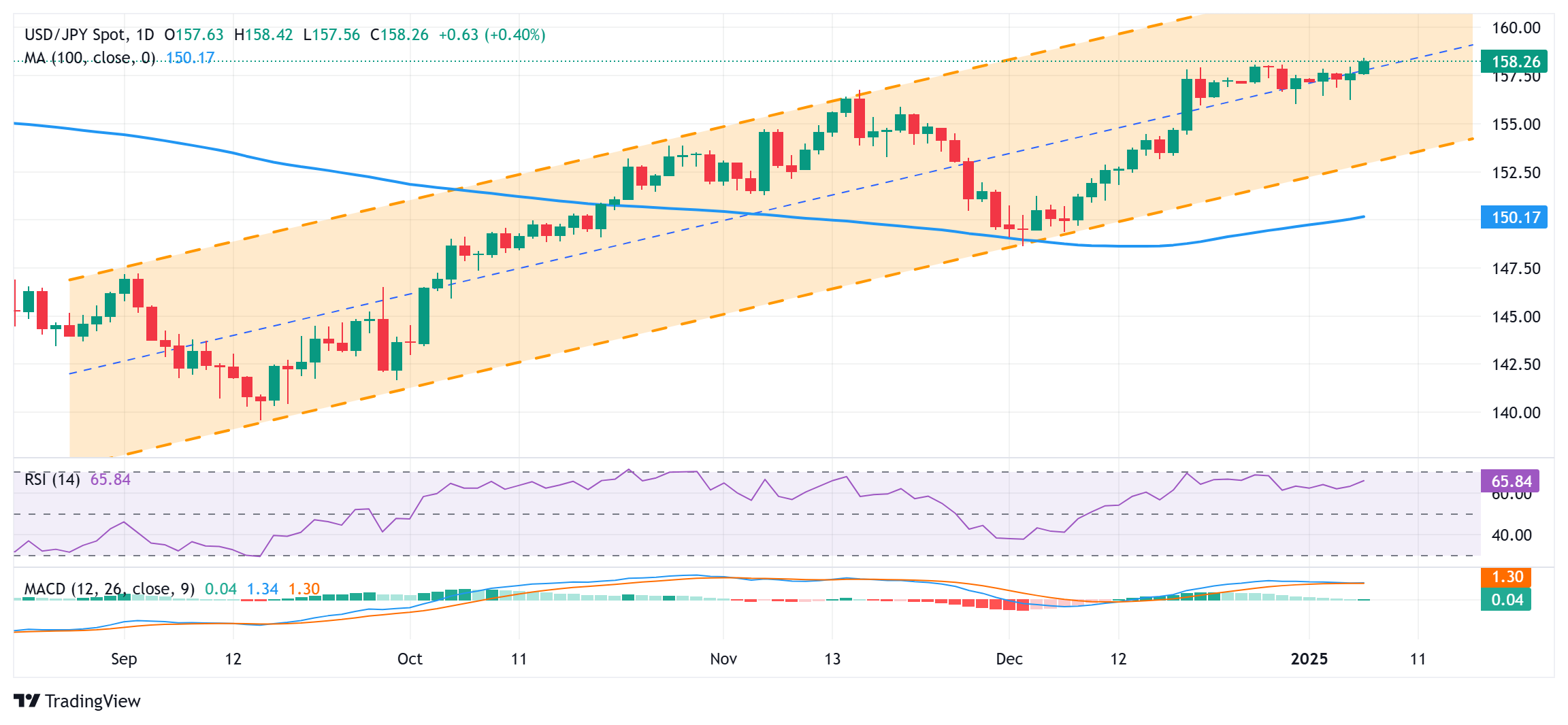Japanese Yen slumps to fresh multi-month low against USD
- The Japanese Yen attracts follow-through selling amid wavering BoJ rate hike expectations.
- The widening US-Japan yield differential and a positive risk tone also undermine the JPY.
- Intervention fears, along with geopolitical risks, could offer support to the safe-haven JPY.
The Japanese Yen (JPY) continues with its relative underperformance on the back of doubts over the likely timing when the Bank of Japan (BoJ) will hike interest rates again. Furthermore, the recent widening of the US-Japan yield differential, bolstered by the Federal Reserve's (Fed) hawkish signal that it would slow the pace of rate cuts in 2025, contributes to driving flows away from the lower-yielding JPY. Adding to this, a generally positive risk tone is seen as another factor undermining demand for the safe-haven JPY.
This, along with the emergence of some US Dollar (USD) buying, lifts the USD/JPY pair to a near six-month peak, beyond the 158.00 mark during the Asian session on Tuesday. Meanwhile, BoJ Governor Kazuo Ueda left the door open for a rate hike at the January or March policy meeting. This, along with speculations that Japanese authorities might intervene in the market to prop up the domestic currency, geopolitical risks and concerns about US President-elect Donald Trump's tariff plans, could support the safe-haven JPY.
Japanese Yen bears retain control amid BoJ rate-hike uncertainty
- The Bank of Japan last month opened up the possibility of waiting longer before the next rate hike, citing uncertainty over US President-elect Donald Trump's economic policies, which continues to undermine the Japanese Yen.
- Trump denied a Washington Post story that his administration will pursue a less aggressive tariff regime and will only target certain sectors in imposing trade tariffs, instead of the broad tariffs promised during campaigning.
- BoJ Governor Kazuo Ueda said on Monday the central bank will raise interest rates further if the economy continues to improve, though he stressed the need to consider various risks when deciding how soon to pull the trigger.
- Furthermore, the broadening inflationary pressures in Japan keep the door open for a potential BoJ rate hike in January or March, pushing the yield on benchmark 10-year Japanese government bonds to its highest level since July 2011.
- Meanwhile, the 10-year US Treasury yield shot to a multi-month peak in the wake of the Federal Reserve's hawkish shift, projecting only two quarter-point rate cuts in 2025 amid still elevated inflation in the world's largest economy.
- The resultant widening of the US-Japan interest rate differential and the prevalent risk-on mood do little to provide any respite to the safe-haven JPY or hinder the USD/JPY pair's positive move back above the 158.00 round figure.
- Japan’s Finance Minister Katsunobu Kato was out with some verbal intervention this Tuesday and said that the government will take appropriate action against excessive FX moves, including those driven by speculators.
- Traders now look to Tuesday's US economic docket – featuring the ISM Services PMI and JOLTS Job Openings – for some impetus ahead of the FOMC minutes and the US Nonfarm Payrolls on Wednesday and Friday, respectively.
USD/JPY seems poised to reclaim the 159.00 mark and appreciate further
From a technical perspective, a sustained move beyond the 158.00 mark could be seen as a fresh trigger for bullish traders and support prospects for additional gains. The constructive outlook is reinforced by the fact that oscillators on the daily chart are holding comfortably in positive territory and are still away from being in the overbought zone. Hence, a subsequent strength towards the 159.00 round figure, en route to the 159.45 intermediate hurdle and the 160.00 psychological mark, looks like a distinct possibility.
On the flip side, the 158.00 round figure now seems to protect the immediate downside ahead of the 157.55-157.50 region. Any further pullback might now be seen as a buying opportunity and remain limited near the 157.00 mark. Some follow-through selling, however, could drag the USD/JPY pair to the 156.25 intermediate support en route to the 156.00 mark. The latter should act as a pivotal point, which if broken decisively, might negate the positive bias and pave the way for a deeper corrective decline.
Japanese Yen FAQs
The Japanese Yen (JPY) is one of the world’s most traded currencies. Its value is broadly determined by the performance of the Japanese economy, but more specifically by the Bank of Japan’s policy, the differential between Japanese and US bond yields, or risk sentiment among traders, among other factors.
One of the Bank of Japan’s mandates is currency control, so its moves are key for the Yen. The BoJ has directly intervened in currency markets sometimes, generally to lower the value of the Yen, although it refrains from doing it often due to political concerns of its main trading partners. The BoJ ultra-loose monetary policy between 2013 and 2024 caused the Yen to depreciate against its main currency peers due to an increasing policy divergence between the Bank of Japan and other main central banks. More recently, the gradually unwinding of this ultra-loose policy has given some support to the Yen.
Over the last decade, the BoJ’s stance of sticking to ultra-loose monetary policy has led to a widening policy divergence with other central banks, particularly with the US Federal Reserve. This supported a widening of the differential between the 10-year US and Japanese bonds, which favored the US Dollar against the Japanese Yen. The BoJ decision in 2024 to gradually abandon the ultra-loose policy, coupled with interest-rate cuts in other major central banks, is narrowing this differential.
The Japanese Yen is often seen as a safe-haven investment. This means that in times of market stress, investors are more likely to put their money in the Japanese currency due to its supposed reliability and stability. Turbulent times are likely to strengthen the Yen’s value against other currencies seen as more risky to invest in.

